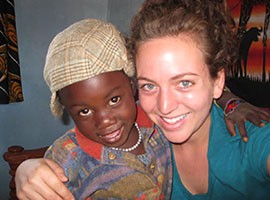Cronkite News has moved to a new home at cronkitenews.azpbs.org. Use this site to search archives from 2011 to May 2015. You can search the new site for current stories.
Cold-calls for the corps: Peace Corps reaches out to recruits, eases process
WASHINGTON – When Scottsdale resident Candy Campbell sat down in October to fill out the application to be a Peace Corps volunteer, she hoped to be fulfilling a lifelong dream.
She didn’t think it would almost take a lifetime to fill out the paperwork.
But the 60-page application required answers to specific, intricate questions, multiple essays – and almost two months for Campbell, at the time a recent Arizona State University graduate, to complete.
“It was a really long application process and it was discouraging,” said Campbell, who was ultimately accepted by the corps and is scheduled to go to Burkina Faso in January.
But over the past nine months, more than 30,000 would-be Peace Corps volunteers have not toughed it out like Campbell, starting but failing to finish the application process.
That worried the agency enough that employees manned phone banks Wednesday to call those 30,000, trying to get them to reconsider. It was part of a broader corps effort to shorten the application process, make it more attractive for would-be volunteers and boost the number of recruits.
Corps spokeswoman Mary Fuller said the new system is “more efficient, more streamlined and more transparent … so they (applicants) can plan accordingly.”
Besides the bulky application itself, it could take six months to a year under the old system for an accepted volunteer to learn his or her placement, Fuller said. Volunteers had no say in where they would end up, and were not told where they would be serving or what they would be doing until they were near their departure date.
Among the changes unveiled this week, the new form is designed to take only about an hour to complete, and applicants are allowed to list three countries where they would like to serve and three jobs they would like to perform.
“The goal is to help people plan and get ready for this opportunity,” Fuller said. “In the past, people just kind of floated through and they never knew where or when they were going. So they will know a start date.”
The changes were welcomed by Kate Glantz, a Phoenix native who did two tours in Africa for the corps before landing a job as a marketing specialist at the agency’s headquarters in Washington.
“I can see where people would be on the fence about joining,” Glantz said, referring to the old format.
She believes the new application will be “huge, because I believe in the life-changing opportunity the Peace Corps can afford” volunteers.
Fuller said 105 current Peace Corps volunteers are from Arizona, which has provided 3,435 volunteers in the 53-year history of the agency. Arizona State University, which currently has 45 alumni in the corps, routinely ranks in the top 25 of large schools whose students volunteer.
Campbell, who is teaching English in France while waiting for her Peace Corps stint to begin, agrees that the new model is likely to attract more people and prevent future applicants from feeling scared or discouraged, as she did.
“I think it’s great that people will have the opportunity to choose where they want to placed and how they want to help,” she said.
She has seen her own assignment shifted from Jordan to Burkina Faso. While she likes that new applicants will be able to indicate a preference for countries where they want to serve, she is concerned about the impact that could have down the road.
“I’m worried that because people will be able to choose where they want to placed and what they want to do, it will take away from countries that really need our help,” she said.
But Campbell, now 23, is ready to help, fulfilling the three goals she has had since she was a little girl: To see the world, join the Peace Corps and help people.








